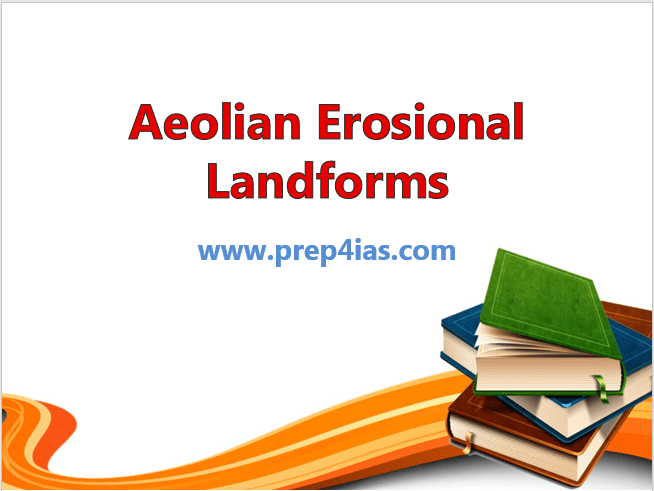In this session, we are going to look into different Aeolian Erosional Landforms. Aeolian processes creates various shapes through both erosion and deposition of Sediments. Here we will only look at the landforms that gets created by the aeolian Erosion processes.
What are Aeolian Landforms
Landforms which are created by the actions of Winds are Known as Aeolian Landforms. The features created by wind could be erosional or depositional. Wind can be involved in erosion, transportation or deposition of sediments over the years which can cause the formation of landforms of different shapes and sizes.

Aeolian Erosional Landforms
Also Read: Important Questions on Seas of the World(Mediterranean Sea, Black Sea, Caspian Sea)
1. Deflation Basin/Desert Hollow/Deflation Hollow
- It is depressional erosional landforms formed due to deflation.
- It involves blowing away of loose or granular particles.
- It can be easily found in Desert areas.
- Deflation creates numerous small pits or cavities over rocky surface. It is due to impact and abrasion of wind blown sand.
- Pang Kiang basin of Mongolian Desert is the perfect example of Deflation Basin.
2. Mushroom Rock/Pedestal Rock
- It is an erosional landforms where base of the rock gets eroded by the variable wind direction.
- When the rock pillars are eroded near their base where friction is maximum, abrasion is high responsible for process of undercutting, as a result structure formed has slender stalk and pear shaped or rounded top called as Mushroom Rock.
- Its shape closely resemble like a Mushroom.
- Giant Mushroom rock of Egypt white desert is a very good example.
3. Zeugen/Capped Inkpot
- Zeugen is erosional aeolian landform in which rock masses having alternate hard and soft layers having
capped inkpot like depression formed. - It's height sometimes may be as high as 30m high.
- Zeugen found in Bahrain Desert is the perfect example.
4. Yardangs
- It is an erosional landforms where hard and soft rocks lie as vertical band and are aligned in the direction of prevailing wind mainly in the exposed desert regions where wind erodes the band of softer rock in long narrow corridors separating the less resistant harder rocks called as Yardangs.
- Yardang ridges height may vary from 5m to 15m and can be as long as a kilometer.
- A large concentration of mega-yardangs occurs near the Tibesti Mountains in the central Sahara is the best example of Yardangs.
5. Mesas and Buttes
- Mesa is a Spanish terminology which basically means "table".
- Mess are flat table like landmass with very resistant horizontal top layer with multiple steep sides.
- Buttes are Isolated flat topped hill created by continuous erosion of mesas over the years.
- The top layer of Butte is a hardened layer of rock that is resistant to erosion. This top layer is called Cap rock which usually is made up of sedimentary rocks.
6. Inselberg or Island Mountain
- Inselberg is a German word and it basically means "Island Mountain".
- Inselberg are isolated residual hills rising abruptly from a virtual level surrounding plain. It is basically one of the erosional landforms.
- They are shaped and thoroughly polished by wind abrasion to shape d resembling Brazil nuts.
- Usually Inselberg contains Igneous rocks like Granite which is resistant to erosion.
- Uluru or Ayer's Rock Inselberg in Australia is the best example.
Popular Recommendations:-
Desert and Its Types: Hot Desert, Cold Desert, Semi-Arid Desert and Coastal Desert
Participatory Notes(P-Notes): An Offshore Derivative Instrument(Advantages and Disadvantages)
17 BRO(Border Road Organisation) Projects in India - Important Points to Remember
50 Important Indian Laws and Rules that Every UPSC/PSC Aspirants Should Know
